Last week we went to University Twente to meet Vera de Pont, our designer, and Klaas and Stephen, two of the students of DesignLab, working on the electronics and the software of the Silence Suit. It was a very exciting day to me. Before, I did not really know what to expect from the meeting. But I planned to take the role of an observer reflecting on how a meeting with people from different kind of disciplines proceeds. I have obtained interesting observations I want to share with you in the following.

Network
When we arrived, Danielle introduced Vera and me to Frank Kresin, the managing director of DesignLab. He warmly welcomed us. He asked us: ‘What is your background?’ I explained where I am from: ‘I am studying fine arts at the art academy St.Joost in Breda. I am finishing my final year and among other things I am doing my internship at Danielle’s Awareness Lab.’ He smiled warmly and said something like it was nice to meet. Vera’s answer was much more professional. She really explained what her work is about and which techniques she is familiar with: ‘At the moment, I am focussing on 3D printing’, she said, ‘so I am especially engaged in the graphical side of design.’ Frank seemed interested and wished us a productive meeting.
After we walked away, I wondered what his question was about. It was all about networking. Danielle explained later that he is into connecting people with each other. I guess that Vera is now saved in his memory and he associates her with the words she dropped within this short encounter. When somebody asks him the next time for a designer engaged in 3D print he will think about her. When it comes to my person, he only associates the intern of Danielle. That is neither good or bad, but the next time somebody asks me such a question I will know what this question is about. I need to name the core concept of my artistic practice in a few words.
I think it is good to be aware of such behavioural codes in the art world as well as in your daily life. As a child you have to learn what the answer should be if somebody asks you ‘How are you?’ We should say: ‘Good. How are you?’ At a certain point those behavioural codes go unknowingly. At the moment I am still the growing child. I am really thankful that I am learning from this internship about the behavioural codes in the art world.
In the course of the meeting I found it really interesting how an interdisciplinary collaboration proceeds. The Silence Suit has to meet many requirements such as beautiful look, stable data and convenient fit. In the following I will reflect on the different kinds of roles of the designer, the technician and the artist.
The role of the designer
Vera de Pont arrived with a big suitcase. ‘I thought it would be better to take some swatches with me, so that we can try different things. The suit itself is not that big.’, she says and laughs. She was well prepared. When we entered the meeting room she immediately unpacked her suitcase and presented the different parts of the suit on a table. I really loved to see how attentive she treated the suit she has made.
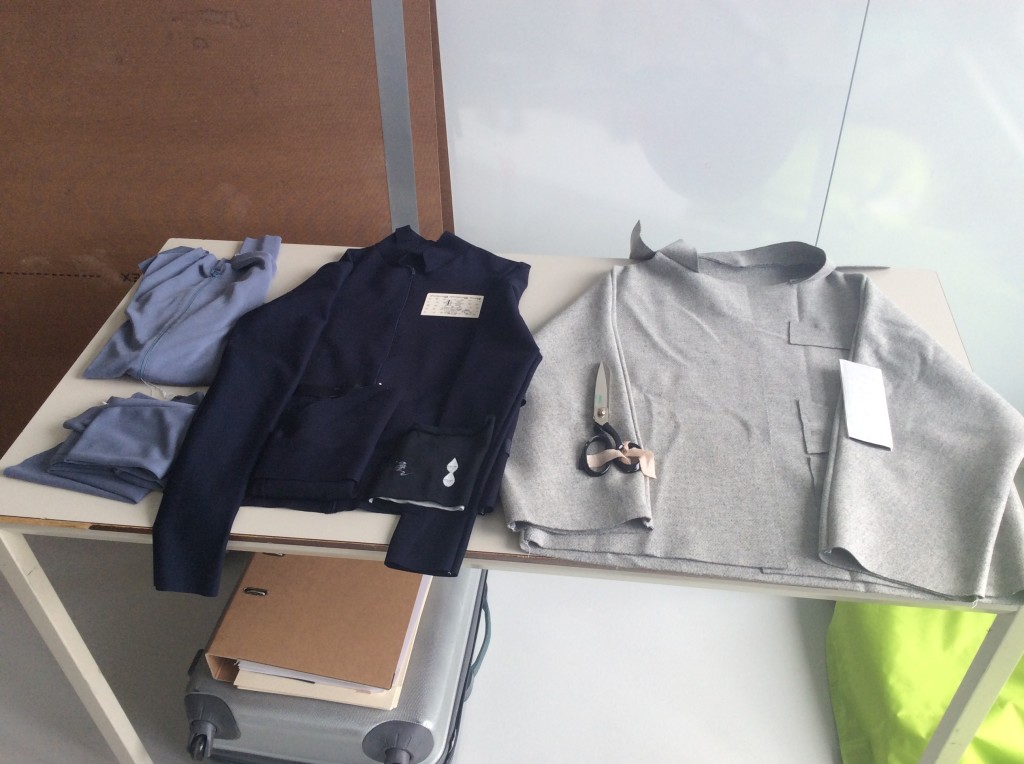
The first half of the meeting was about the progress of the electronics. She had many practical questions for the technicians about the look of the badge and the microcontroller container, so that she could include it in the following sketch of the suit. She properly wrote down every information she got about the electronics. In that first half of the meeting, the role of the designer was to understand as much as possible of the electronics to optimise the design of the suit.
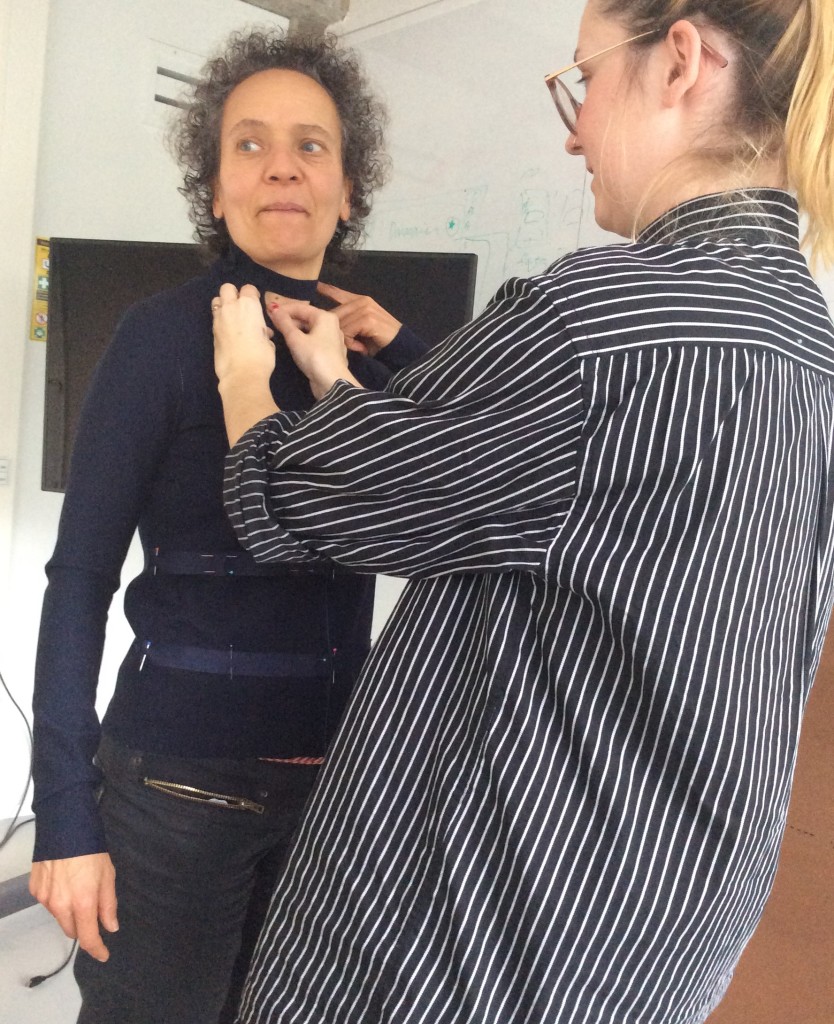
The second half of the meeting was really about the fit of the suit. Vera seemed very excited when Danielle fit the suit. ‘It is so nice to see it on you.’ She said with a great smile on her face. It fits very well and she seems pleased that Danielle likes it. We have to think of each sensor, where it should be placed and how the cable connects to the microcontroller. Vera came up with new ideas how we could bring the electronics and the design together until everyone agreed. Her arguments were mainly about the look and that it should be as comfortable as possible for the user to maintain the suit. I was really impressed how focused she stayed during the whole meeting. In the second half of the meeting the role of the designer really seemed to be a living source of inspiration. She really thought in options instead of problems.
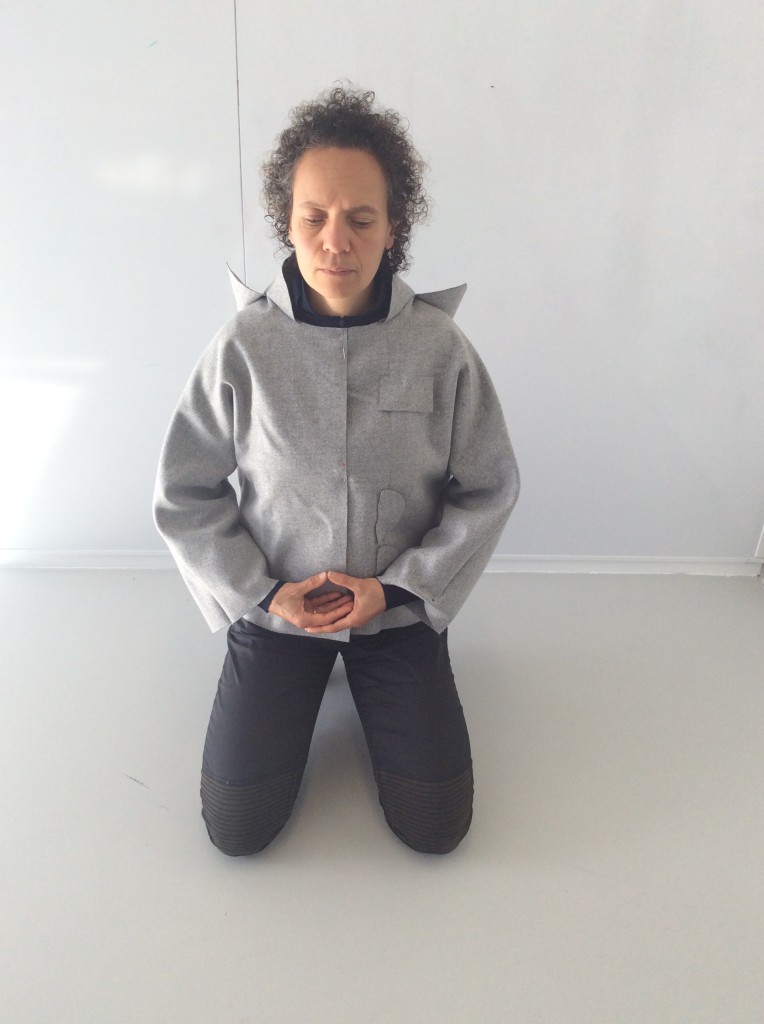
The role of the technician
Stephen and Klaas are both master students of University Twente participating in the DesignLab working on the software and the electronics of the Silence Suit. The DesignLab seemed to feel like home to them and I experienced how deep they are into the subject. They even worked through their lunch break. Before we met, they have worked many hours to optimise the construction of the badge and the microcontroller PCBs. They were able to minimise the number of plugs. Stephen and Klaas seemed happy about the outcome of their research.
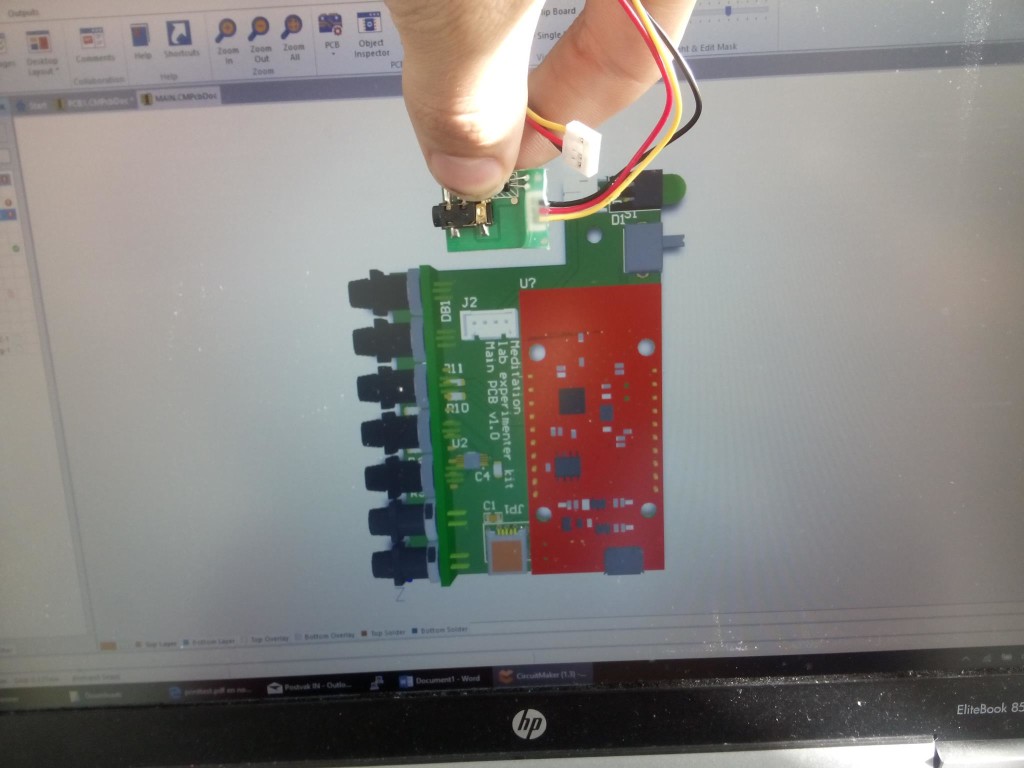
Finally, they got a nice sketch of the electronics. But still, Vera and Danielle had some questions about optimising the electronics. For example, a screw connection of the plugs would be better than a clicking one. The argumentation of the technicians was mainly based on what the market offers. If there are no screw connections for that kind of plugs, they cannot do anything about it. But they were also trying to understand Danielle’s vision of the suit to bring it to a higher level on the field of electronics. They came up with the idea to change the light sensor with the wind sensor on the badge, so that the shadow of the plug will not influence the data. I enjoyed to see how they tried to think in the artist’s shoes.
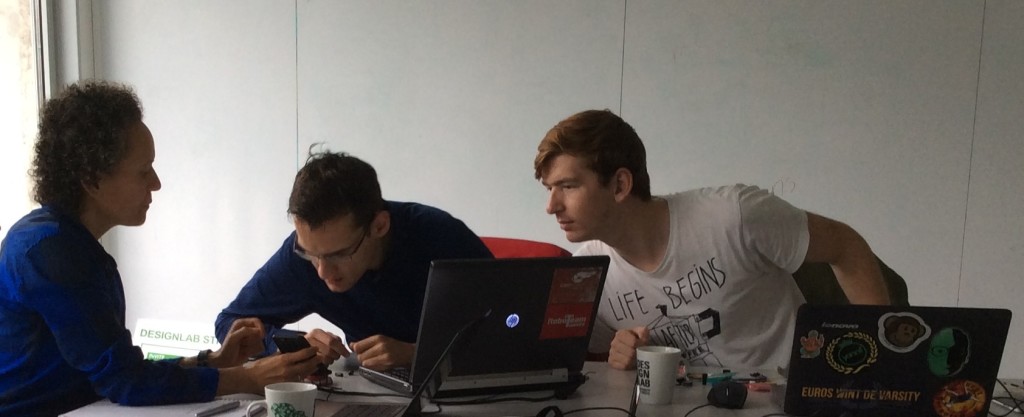
The role of the technician stayed the furthest away from me. I was really impressed how much they know about their subject, but I only understood some of it. Still, I see the role of technician as a really practical one. In contrast to a designer or an artist who create things, the technician’s choice is more depending on existing things.
The role of the artist
I think the role of the artist is a really personal choice. Every artist has to formulate his own criteria. In the following I will try to characterise the role of the artist as I observed it in the case of Danielle during the meeting with Vera, Stephen and Klaas. Danielle herself told me once that she sees her own artistic practice in bringing things together. Her personal fascination leads to the vision of a project. In this case her vision is about Hermitage 3.0. The role of the artist here is to plan smaller steps to realise that vision. One of these steps is the Silence Suit as a part of Hermitage 3.0. Within that project the artist has to look for experts and people she wants to collaborate with. That is why we are sitting in Twente around a table with Vera, Klaas and Stephen.
During that meeting, Danielle kept on task all the time. But for me it seems very difficult to find the balance between practical choices and visual choices without losing your vision. For example, when Klaas told her that there is no screw connection for that kind of plug, she did not want to believe it and asked him to research once more. She asked it in a very respectful way, but I witnessed that an artist does not want to depend on existing things. Maybe Danielle’s role as an artist is comparable to a tinkerer.
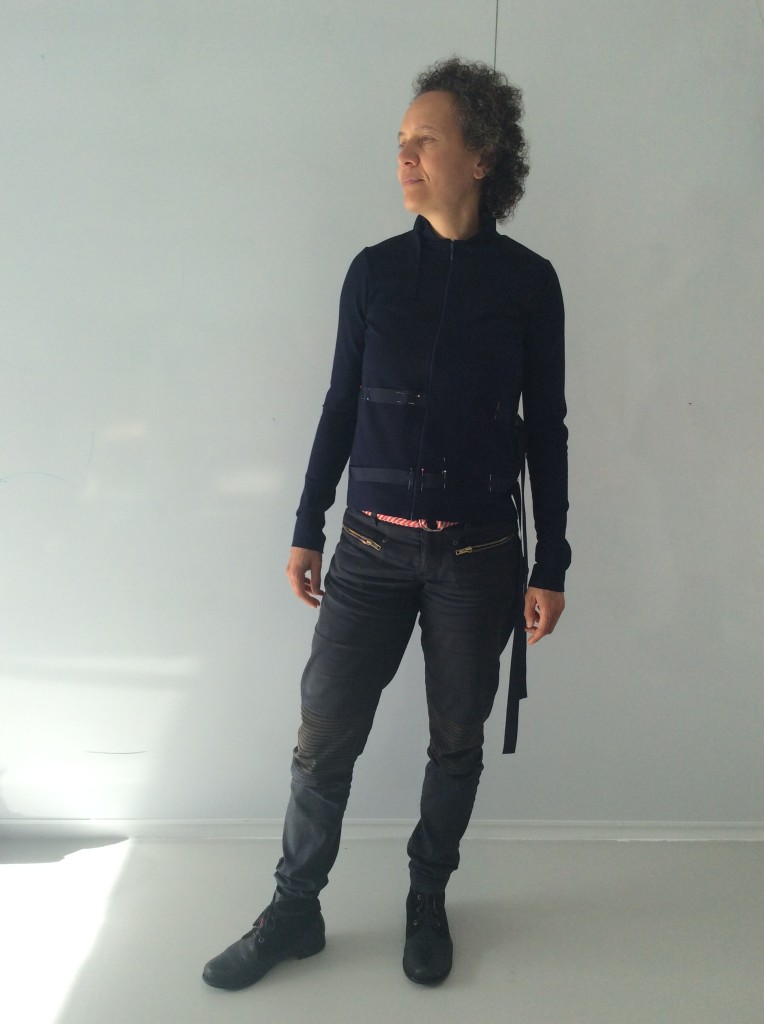
Generally speaking, I think that an artist has to offer alternatives to existing structures. In my opinion, Danielle contributes valuable aspects by collaborating with different kind of disciplines. She creates her own universe by utilising different kind of research as a source of inspiration. The collaborations and the diversity of sources of inspiration make that she comes to a vision which could not have been thought out by one person.
To conclude this eventful day, it can be said that I acquired an in-depth view on how a collaboration in that professional environment looks like. I have especially learned a lot about the role of an artist by seeing how Danielle defines her artistic practice. That helps me to think about my future position in the art world.